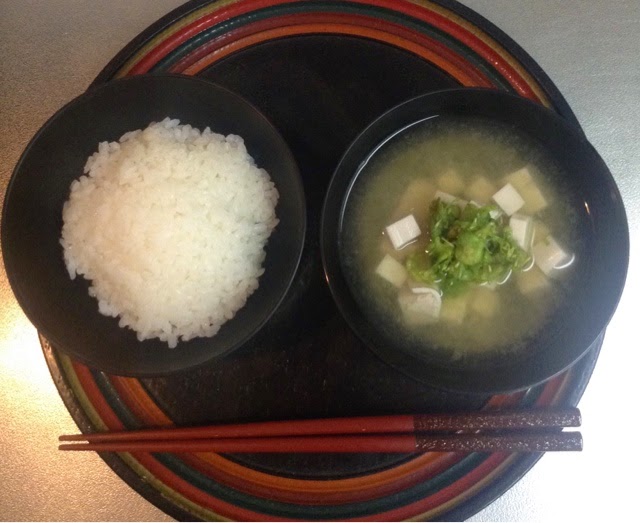 |
| Fukinoto growing in our garden |
 |
| Plain rice and fukinoto miso soup |
Fresh home-made food every day
 |
| Fukinoto growing in our garden |
 |
| Plain rice and fukinoto miso soup |
This is the end of the year at the university and it is a busy time for both professor and students. Recently, I’m coming back home later and later in particular because this no excuse not to go to the gym. Last night after my pilates class I needed a very quick fix for dinner so that it allowed me to have some time to prepare the apartment for my sister’s visit later this week (yes! Prunellia is flying to Tokyo very soon!).
I left it on low heat, time to do the other tasks I had to do. Then once ready to eat I added a can of drained chick peas and served with baby leaf salad, olive oil and linen seeds. Delicious, warm and slightly spicy!
Probably the last time I talk about purple sweet poratoes this year! There seems to be no more at the cooperative shop.
 I really love okara. It’s basically the pulp of soya beans remaining after the fabrication of tofu and soya milk. It’s full of proteins and it as a very mild taste. It is easily found in supermarket in Japan (together with tofu, nato and yuba) and also very easy to use in several recipes. The most famous okara recipe in Japan is probably u no hana (うの花). A mixture of okara and cooked vegetables.
I really love okara. It’s basically the pulp of soya beans remaining after the fabrication of tofu and soya milk. It’s full of proteins and it as a very mild taste. It is easily found in supermarket in Japan (together with tofu, nato and yuba) and also very easy to use in several recipes. The most famous okara recipe in Japan is probably u no hana (うの花). A mixture of okara and cooked vegetables.
Since I found nice okara, I wanted to make u no hana, but as always I twist the recipe. Usual u no hana is often very mild in taste and in color, and recently I like colorful plates for dinner (see my recent post). So instead of the classical ingredients I used carrots, purple sweet potato (again!), shiitake and na-no-hana (rapeseed).
 I cut in small stick all the vegetables and cook them in the above order in a bit of oil and finally added soya sauce, a little of sugar, a little of sake (the original recipe has mirin in it, but recently I don’t use mirin anymore, for it’s too strong taste that covers the taste of the other ingredients).
I cut in small stick all the vegetables and cook them in the above order in a bit of oil and finally added soya sauce, a little of sugar, a little of sake (the original recipe has mirin in it, but recently I don’t use mirin anymore, for it’s too strong taste that covers the taste of the other ingredients).
Finally I added the okara and stirred (a little too well so that the purple color of the potato transferred to the white okara:( ).
A delicious colorful vegan dish, served with rice and ume-boshi.
It’s been sometimes I wanted something that changes from the usual scones/pancakes/crepes… I often prepare for breakfast and I was longing for English crumpets. I checked on my usual resource for English recipes: the bbc website and thought I could make crumpets right away. Not so simple. You need circles to bake them and you need baking soda, and instant yeast something I not often use. I must admit that I had to do some research too about the differences between instant yeast, active yeast, baking powder and baking soda…
Sometime it’s nice to have a drink and a few snacks to go with but no junk, no nuts nor cherry tomatoes…
One of the easiest Japanese dish to cook is curry-rice (pronunce “karey-rayiss”). I like because it is quick to prepare, and it’s a warm dish you can make with whatever you have in the fridge: perfect for a Sunday lunch after spending hours in the cold treaming trees in the garden. You can use only vegetables, meat, fish or mix vegetables with meat or fish. The variety of ingredients has only the limit of your imagination! So once decided what to put inside it is super easy. I always start with an onion or a leek that I cook with a bit of oil (olive or not) or butter. Once almost brown I add carrots, sweet potatoes, potatoes, meat if any… And half cook them. Then I add a spoon of curry spice, the quantity depends on how strong you like your curry, I like mine tasty but not hot.
Proudly powered by WordPress | Theme: Baskerville 2 by Anders Noren.